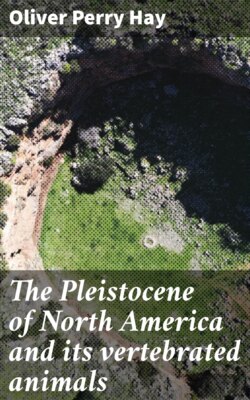Читать книгу The Pleistocene of North America and its vertebrated animals - Oliver Perry Hay - Страница 33
На сайте Литреса книга снята с продажи.
MASSACHUSETTS.
ОглавлениеTable of Contents
12. Gay Head, Martha’s Vineyard.—In his “Travels in North America,” volume I, 1845, page 257, plate V, figure 1, Lyell announced the finding of a part of a skull of a walrus at Gay Head. This he had purchased from a fisherman who lived there and who said it had fallen out of a conglomerate found at that place and which contains bones of cetaceans. The skull retained but a small portion of its animal matter. Richard Owen, to whom the skull was shown, regarded it as belonging to a species distinct from O. rosmarus. The upper jaw contained the base of one tusk, the socket for the other, and 3 molar teeth on each side. The reduced number of molars furnishes no distinctive character, for existing individuals sometimes present this number. The base of the tusk has its transverse diameter greater than usual relatively to the fore-and-aft diameter. According to Lyell’s illustration of the specimen, the greater diameter was 70 mm., the shorter 53 mm. The writer has seen no tusk of O. rosmarus as thick as this; but the thickness is variable and may possibly attain to two-thirds of the greater diameter.
Inasmuch as the Tertiary deposits at Gay Head, rising above the sea to a height of about 150 feet, are capped by a sheet of glacial drift and clays, it is probable that the skull in question had fallen from some of these drift deposits. According to Professor J. B. Woodworth (17th Ann. Rept. U. S. Geol. Surv., pt. I, p. 982), there are at Gay Head deposits of drift which represent some of the older glacial stages as well as the last one, the Wisconsin. It is possible, therefore, that this walrus lived there as far back as the middle of the glacial epoch or even earlier. For additional information on the geology of that island consult Woodworth’s paper, in which the literature is cited; also the important paper by N. S. Shaler (7th Ann. Rept. U. S. Geol. Surv., 1888, pp. 303–363.)
The hooded seal, Cystophora cristata, has probably been found fossil at Gay Head. The only reason for this supposition is found in a statement made by Charles Lyell (Proc. Geol. Soc. London, vol. IV, p. 32; Amer. Jour. Sci., vol. XLVI, 1844, p. 319). He says that with other remains on Martha’s Vineyard he found a tooth having the crown fractured. Lyell submitted the tooth to Richard Owen, who pronounced it to be that of a seal which seemed to be nearly allied to the modern Cystophora proboscidea (C. cristata). It seems quite probable that this species lived there at the time when the walrus haunted the region. It is of course possible that the remains reported belonged to an animal that lived in that region as far back as the Miocene. The tooth was not described or figured.
